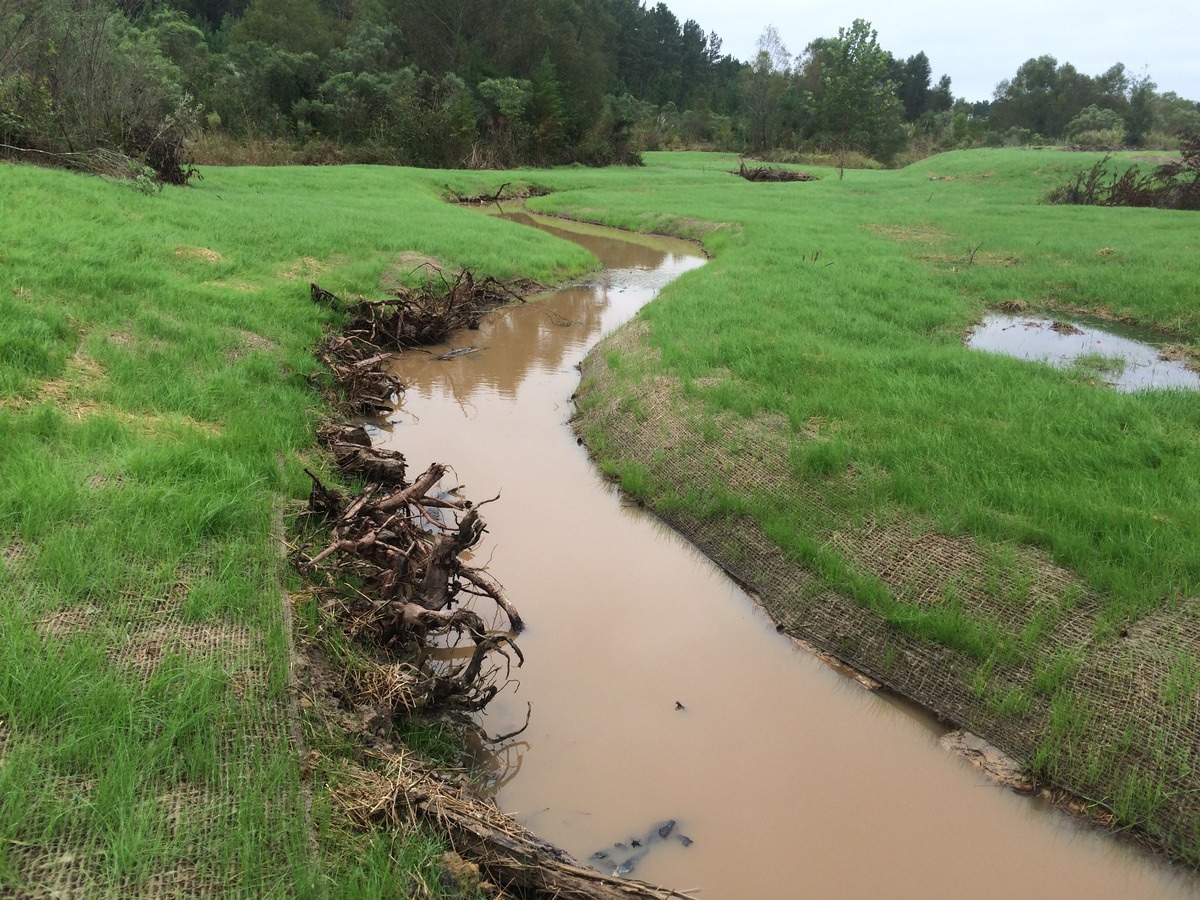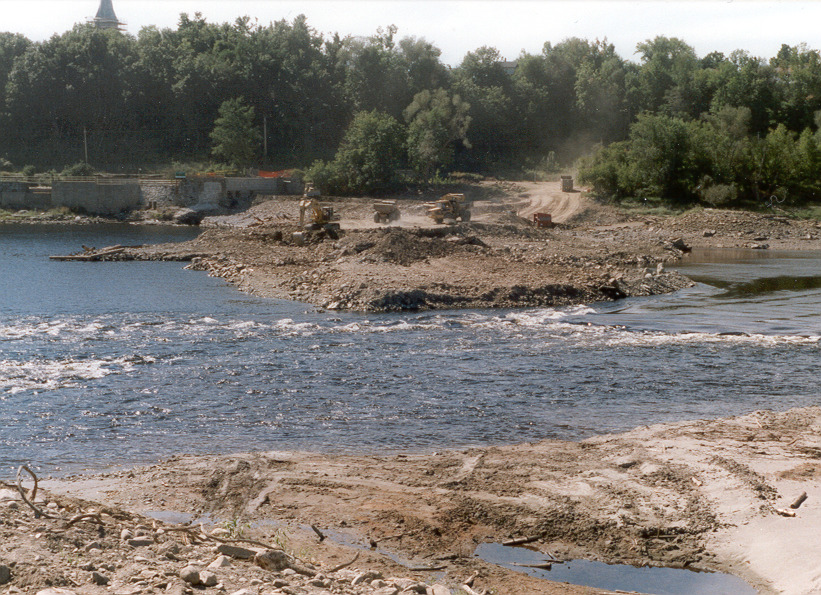Co-authored with Will Medlin, PWS, ENV, SP
As capital improvement and critical infrastructure plans move toward more sustainable frameworks, aging dams that have outlived their intended purpose may become targeted for removal. Many dams cause harm to natural ecosystems, require costly maintenance and inspections, and pose potential hazards due to risk of failure. Dam removal and the ecological habitat restoration of natural floodplains, wetlands, and waterways are typically a net positive for the environment, property owners, and the public.
Funding through public or private grant programs is often available for aspects of dam removal, particularly those that afford opportunities for significant habitat restoration. The restoration of wetlands and natural stream channels for fish and aquatic species passage are intrinsic environmental benefits of dam removal that make tributaries and their ecosystems more resilient and sustainable. Turning a potential source of liability into an investment in the environment and local ecosystem gives these projects access to many private, federal, and state grants that can help defray the cost of sediment management. Woodard & Curran’s Funding Assistance Team tracks these opportunities and assists with applications. If you are interested in subscribing to their newsletter please contact Jessica Richard, Program Manager.
When considering certain dam removal or stream restoration projects where contamination risks are present in the environment, ecological assessment, sampling of various biotic and abiotic media, and subsequent sediment management may represent the most labor intensive and expensive project tasks; and funding sources are scarce. Minimizing the project lifetime costs of sediment management requires a detailed and holistic conceptual site model (CSM) approach used to focus sampling efforts, identify the most appropriate cleanup standards, and ultimately identify the most cost-effective and sustainable solution.
Woodard & Curran uses a multidiscipline team approach to develop a CSM that helps optimize site investigation, and integrates a risk-based approach to remediation, restoration, and long-term sustainability efforts to limit costs due to sediment sampling, management, and disposal.
- Establishing the most concise sampling plan needed to accurately assess site conditions
- Accurately establishing the naturally occurring background levels of contamination
- Accurately establishing appropriate cleanup criteria for contaminants using a risk-based approach
- Optimizing cost-effective sediment reuse and limiting disposal costs
- Development of streamlined remedial action work plan, environmental permitting strategy, and construction oversight plan.
The following project examples demonstrate this approach in action:
Saraland, LLLP – Georgia

In 2006, after getting an unfavorable response from the US Army Corps of Engineers, Savannah District office at the request to create a private recreational lake, a middle Georgia landowner willingly decided to embark on one of the largest Clean Water Act Section 404 wetland fill violations in EPA Region 4 history. The landowner hired a roadway grading contractor to construct a 500-foot-long and 23-foot-high dam that created an approximate 250-acre open water impoundment. Construction of the dam and the resultant flooding of the lake adversely impacted over 100 acres of palustrine freshwater wetlands and 3.5 miles of stream channel.
An investigation and bankruptcy case ensued and ultimately the US Department of Justice filed an enforcement action lawsuit against Saraland, LLLP. In 2013, Woodard & Curran was engaged to conduct ecological assessments and environmental permitting strategy for phased dam removal and aquatic and terrestrial habitat restoration. Woodard & Curran led the restoration planning and design, stream channel geomorphology surveys, CWA and NPDES permitting, and construction oversight of the activities required to restore the wetlands, stream channels, and riparian area surrounding the former lakebed. The EPA’s enforcement action and administrative compliance order included breaching the dam, draining the man-made lake, and restoring the native bottomland hardwood forest, seepage slopes, and natural drainage to pre-flooding conditions to the extent feasible. Portions of adjacent xeric sandhill scrub uplands were also enhanced through revegetation with native species appropriate for the region.
Construction began with a controlled breach of the 50,000-cubic-foot dam to drain the lake. Woodard & Curran designed downstream erosion and sedimentation controls and performed NPDES inspections and required turbidity monitoring. Per a request by the US Fish and Wildlife Service, the restoration design and dam removal plans were slightly modified. The final plans called for re-establishment of the historic stream channel and construction of a wetland slough that would connect to the existing natural stream channel and adjacent floodplain wetlands downstream of the dam.
The second phase of construction included earthwork to support revegetation and restore hydrology, final removal of the dam, and planting to restore the forest and native plant community. A small portion of the dam would remain in place which tied into existing floodplain terrace uplands on the downstream side of the dam providing some habitat connectivity.
In the end, the project restored ecological habitat conditions for approximately 250 acres of bottomland hardwood forest habitat and over three miles of coastal plain stream channels. Nearly twelve years passed from the initial wetland fill violation to final resolution. This project demonstrates Woodard & Curran’s commitment to solving our clients most complex water and environmental challenges. It was an extraordinary, collaborative effort that left both our client and the regulatory agencies completely satisfied.
Edwards Dam – Maine

In a precedent-setting decision, the Federal Energy Regulatory Commission mandated the removal of the 162-year-old Edwards Dam on the Kennebec River in Maine. The mandate, which would reopen a 17-mile stretch of the river to 10 species of native sea-run fish, required complete removal of the dam. This decision represented a major shift in public policy in response to a growing public desire to balance economic interests and the quality of our environment.
The Maine State Planning Office selected Woodard & Curran and E-PRO Engineering to design and provide construction oversight for removal of the Edwards Dam on behalf of the Maine Department of Marine Resources. The Woodard & Curran and E-PRO engineering team was assigned full responsibility for engineering design, environmental planning and permitting, and construction management of dam removal and site remediation/restoration activities as well as pre-and post-removal monitoring of the river embankments and associated structures.
Woodard & Curran evaluated sediment quality and transport impacts, hydraulic analyses for dam breach alternatives, and the team developed a site restoration plan that addressed physical and chemical hazards identified within the site structures scheduled for demolition and in surface and subsurface soils. The team was given less than three months to prepare and submit all dam removal plans and environmental permit applications as well as produce a reliable cost estimate for the state to use in making its final dam removal decision.
The team worked with local, state, and federal public safety and emergency management agencies to coordinate and oversee the initial breach of the 24-foot-high,917-foot-long dam and subsequent dam removal work. The dam removal project was further complicated by re-routing of an existing combined sewer overflow across the site, design and permitting of a diffuser for an abutting wastewater treatment plant, as well as protection of a fragile gravity sewer line beneath the primary access route for hauling dam material to the disposal site.
The project was accomplished under an aggressive timeline and budgetary constraints. Cost was considered as an important factor because the project had secured funding under the comprehensive settlement based on initial cost estimates prepared in anticipation of dam removal. The project could have been canceled if construction cost estimates exceeded the amount.
Every site is a different puzzle requiring a multidiscipline team to work together and with regulators to find a successful solution. Using a CSM to formulate and communicate an optimized approach to complex dam removal and sediment remediation sites leads to the most cost-effective and sustainable solutions. Mitigating dam failure risks, reestablishing free-flowing waterways and reconnecting natural riparian ecosystems are net positives to both the environment and human populations.
